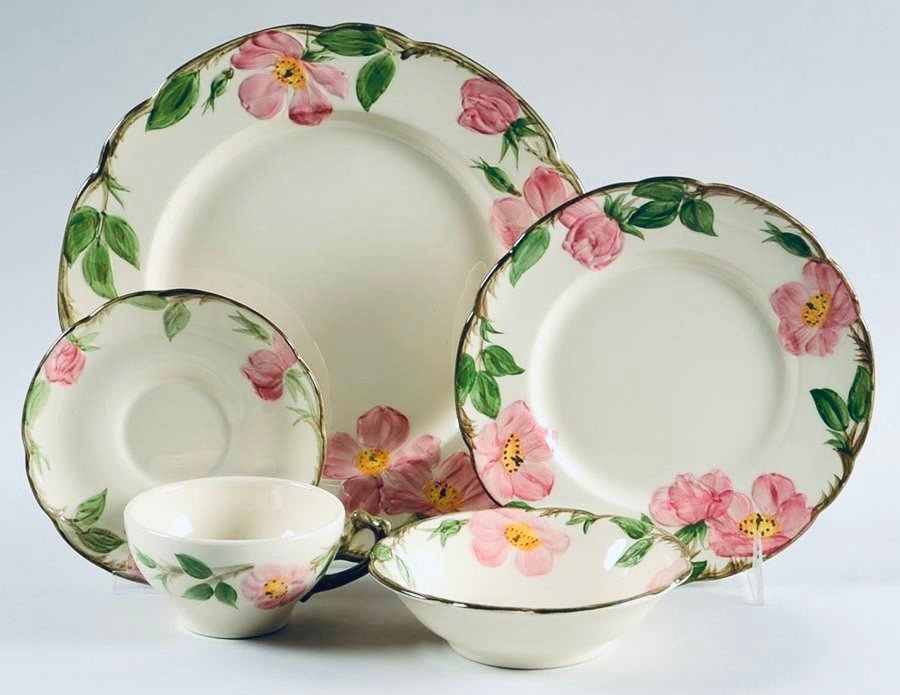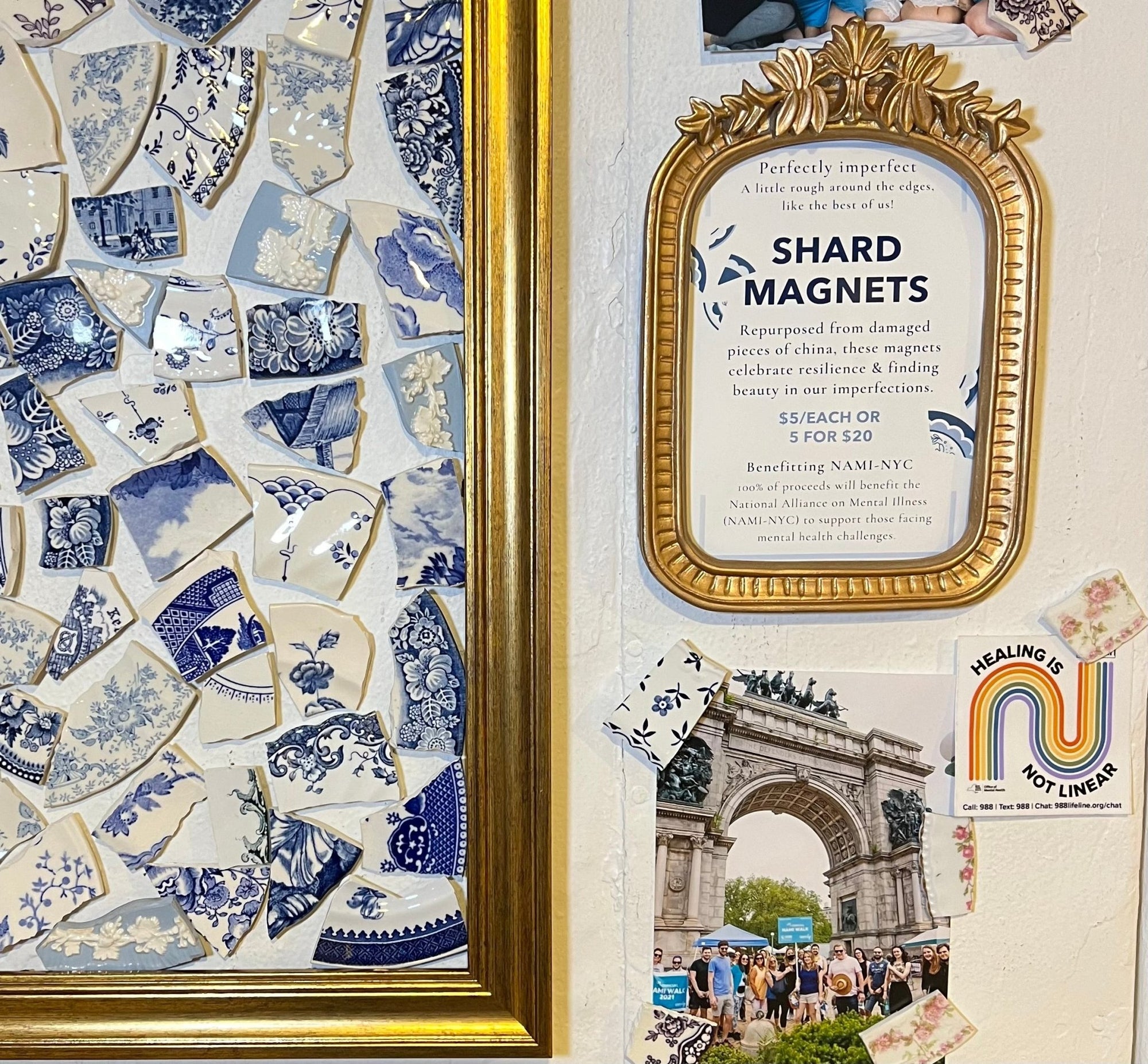Inspired by the beautiful pink rosa rugosa flower, Franciscan's Desert Rose dinnerware line was a beloved, highly successful china pattern from 1941 to 2004. Though no longer in production, it remains one of the most popular china patterns in American history and is still highly sought after by collectors.
What's the story behind the iconic Desert Rose pattern?
Desert Rose was first introduced in 1941 by Gladding, McBean & Company, which was known for producing casual dinnerware in the style of Mexican folk pottery. It was created by contract designer Annette Honeywell (1902-1959) of Los Angeles in a style considered to be typical of Asian- inspired Southern California décor of the early 20th Century.
With hand-painted clusters of vibrant pink flowers, olive green stems on a cream background, and brown branches gracefully forming the trim of each piece, Desert Rose has a definitively rustic California aesthetic.
Interestingly, the rosa rugosa, the recognizable flower that's central to Desert Rose's design, is native to the Midwest and northern sections of the United States. The pattern was named Desert Rose, however, after a flower native to California to give it the West Coast cachet that was so coveted at the time.
How did Desert Rose dinnerware become popular?
Desert Rose china became popular for its unique design. The bright pink and green hues of the pattern gave it a vintage charm that was unlike any other dinnerware patterns in circulation at the time.
Franciscan’s pattern got a significant boost in popularity thanks to widescale advertising campaigns throughout the 1940s and 1950s that featured Hollywood celebrities such as Joan Crawford, Greer Garson and Dorothy Lamour. In 1964, the sixty millionth piece was produced and First Lady Jacqueline Kennedy chose Franciscan Desert Rose for use in the White House.
Desert Rose is considered to be durable and resistant to chipping (though this is not always true in our experience!). Collectors believe that these attributes contribute to the pattern’s staying power, especially among those who used it for everyday dining.
Production of Desert Rose china from 1984 to 2000
Desert Rose china stopped being produced by Franciscan in the 1980s due to increasing costs of raw materials and production. In 1984, Franciscan Ceramics was sold to Josiah Wedgwood and Sons Ltd. Following the sale, production of Desert Rose was moved to England. In 2000, production again moved—this time, to China (the country, that is!).
Several unfortunate changes were made to the pattern after production left the United States. Most noticeably, some of the finer details like the scalloped edges and pronounced reliefs of the flowers, leaves, and branches faded away.
You can easily spot some of the differences in this picture comparing 3 dinner plates from the three countries where Desert Rose was produced. Photo credit to blogger Jerry Garrett.

If you’re looking to add to your collection or gift something to a lover of Desert Rose, we recommend that you look for backstamps indicating that the piece was made in the U.S.A.
Is Franciscan Desert Rose china still popular today?
The rise of eBay in the 2000s hurt sales of Desert Rose china by flooding the market with low-cost, low-quality knockoffs of the pattern. This caused many people to be wary of purchasing Desert Rose china and damaged the reputation of the original pattern. The demand for the pattern also began to decline as tastes in dinnerware patterns changed with the times.
After decades of popularity, Franciscan Desert Rose was discontinued in 2013. Despite this, Franciscan Desert Rose china is still popular today. The pattern has become a classic, and many people are still drawn to its unique design and vintage charm.
Many of our customers seek out and request our handcrafted designs made from Desert Rose patterns.
The enduring popularity of Franciscan Desert Rose China is a testament to its timeless design and superior craftsmanship. It still holds a special place in the hearts and memories of many and will forever be remembered as a beloved mainstay in American households circa mid-to-late 20th century (and beyond!).
We'd love to hear whether Desert Rose lives on in your home. Do you use it? How? If not, why? Leave a note in the comments below.
We can't wait to tell you about how one of of our customers upcycled her family's set into pieces she and her family use and enjoy... sign up for our mailing list below to get updated when our next post comes out!
Resources consulted:
- www.gmcb.com/franciscan
- https://tutuhut.com/how-much-is-franciscan-desert-rose-china-worth/
- https://www.gr8ampottery.com/desert-rose.html
- https://jerrygarrett.wordpress.com/2021/05/17/el-rancho-the-surprising-origins-of-desert-rose-dinnerware/




Comments
I was wondering if your stamped dishes from the time period of 1964 has the gold F on the bottom.
This is the type of my small set of Desert Rose so it does not say microwave safe, there is no black F on it
(as some fake that marking and it does wash off) Made in England is the middle time frame 1985 to 2000.
Happy Trails to all and make it a great day to Be You Ti Full
Still love these. Started with a few yard sale pieces in college in the 80’s, and been adding to them ever since. Soon noticed the differences, and now I only buy the originals, I think they are so much more beautiful. Use the smaller, lighter weight ones day to day (since I’ve gotten older and a bit arthritic 😂 ), and the dinner plates for special occasions.
Thanks for the info and pics!
My grandma had Desert Rose and my mom had Apple. I have my grandma’s set and my brother has my mom’s. We both use them daily. Love both patterns. Makes everything taste like childhood.
I inherited a set of Desert Rose from my grandmother, but have never used it because it was my understanding that it could not be washed in the dishwasher, and I chose not to have to wash it by hand! Turns out I’m wrong? (I hope!)
I grew up with this Desert Rose pattern. My parents lived in California in 1960 (the year I was born). I inherited a full set of it including two serving bowls, one round and one divided, two serving platters, coffee cups and saucers and a sugar and creamer set. Lovely!
I inherited pretty much a full set of Desert Rose from a great aunt. In the late 1980’s, it was added to by myself & my mother. I’m sorry that it is out of US production.
My mother who passed in 2023 was 98. She had 20 3 piece settings. On holidays we would always use them. This Easter in 2024 I used them. It felt like mom was there with us. I plan to pass them to my daughter.
My mother who passed in 2023 was 98. She had 20 3 piece settings. On holidays we would always use them. This Easter in 2024 I used them. It felt like mom was there with us. I plan to pass them to my daughter.
My sister and I inherited my grandmother’s purchased in the 40’s. I have som added from the late 90s . My intention is to leave to my 3 grandsons,each getting a 6place setting. It has great sentimental value to me, as I think of my dear Nanny – I love the beautiful rose buds on the serving dishes,butter dish and the salt and pepper shakers. I also love the mugs which I use every day!
I truly love my Dessert Rose. I have both those made in USA and England. I also have hand painted drinking glasses with the Dessert Rose pattern on them. I use my Dessert Rose collection for all special occasions. Your artical was very interesting and I learned a lot from reading the story and comments. I want to educate my children who will inherit the dinnerware. Thank you for your posts.